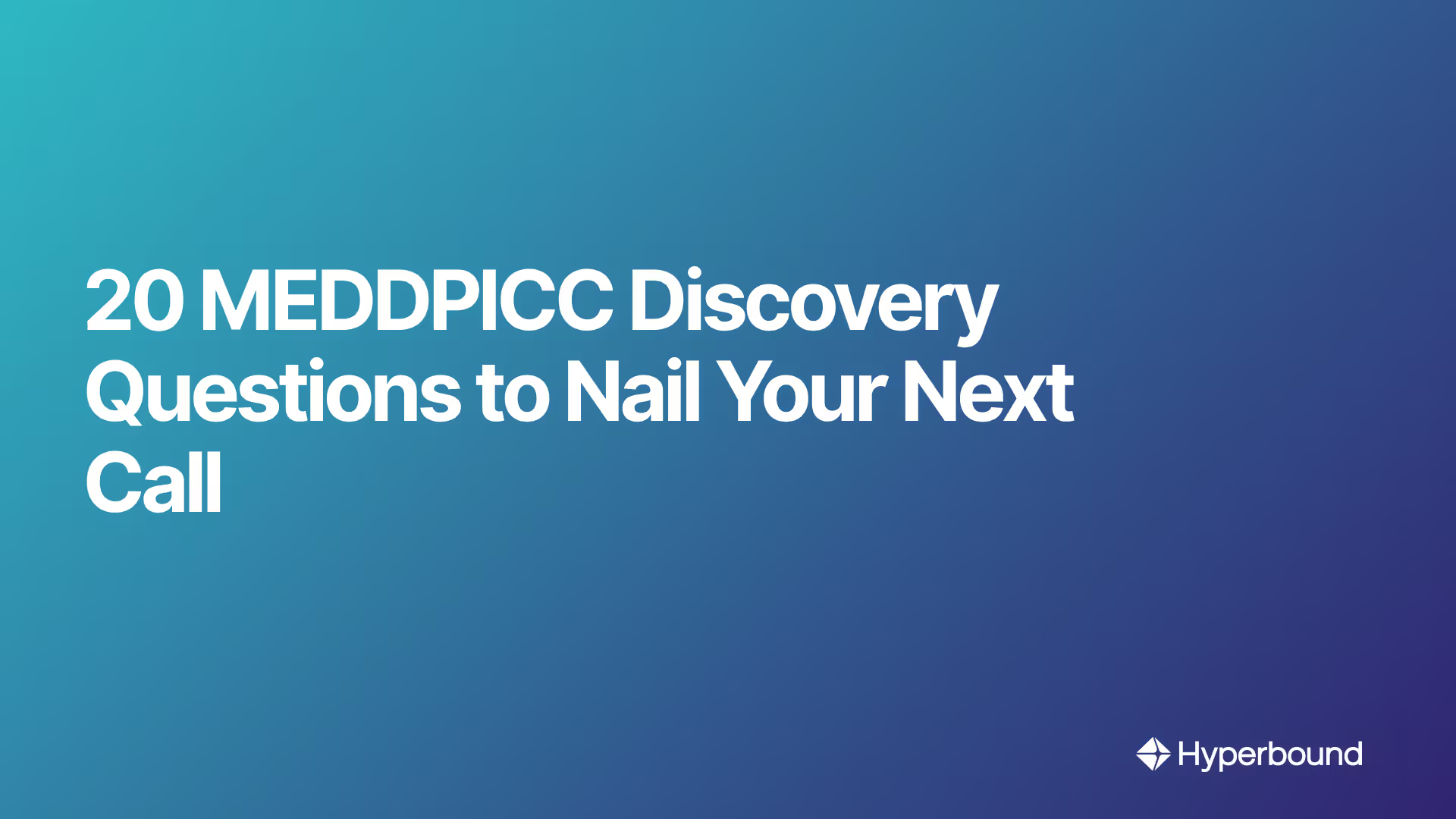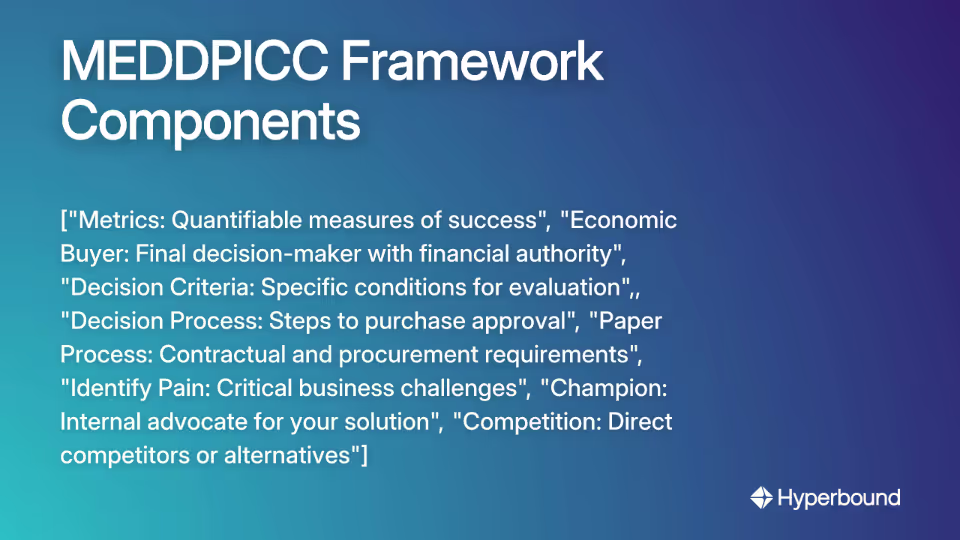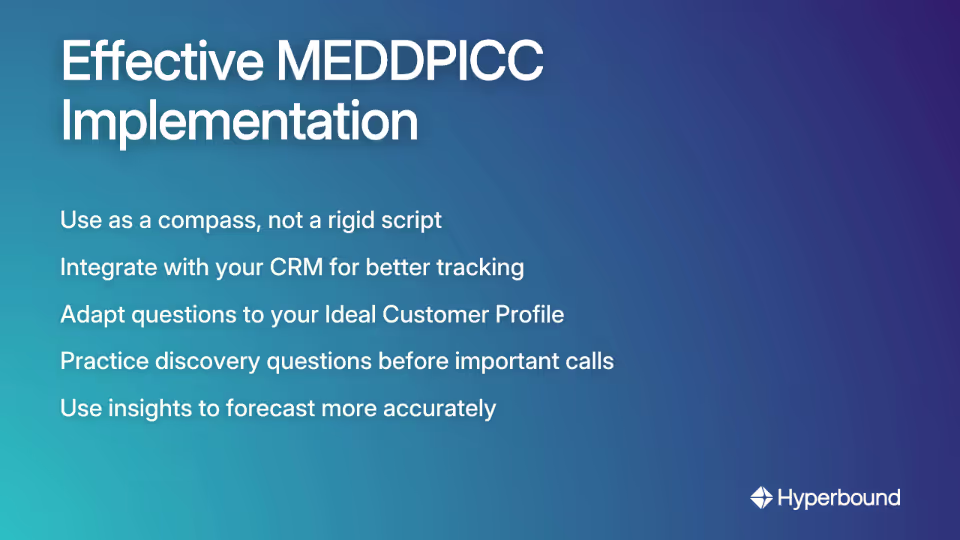
You've set up the perfect enterprise sales call. You've done your research, prepared your slides, and practiced your pitch. But as the meeting approaches, that familiar pressure builds—will you uncover the right information to move this deal forward, or will you miss critical insights that could derail your entire sales process?
In complex B2B sales, the difference between closing a deal and watching it stall often comes down to what you discover in those crucial early conversations. Yet many sales professionals struggle with "orchestrating the full sales process end-to-end, especially in complex enterprise deals."
This is where the MEDDPICC framework shines. While some sales methodologies can feel rigid or inauthentic ("most of that stuff is garbage and leads to bad sales practices"), MEDDPICC operates differently. It's not about running through a robotic checklist with your prospect—it's an internal compass that ensures you gather all the critical intelligence needed to navigate complex deals successfully.
As one enterprise sales professional put it, "MEDDPICC was a game changer for me." The beauty of the framework is that "my client doesn't know I'm doing it and I'm very real with them." You can extract the information you need through natural conversation, while maintaining authenticity and trust.
Let's dive into what MEDDPICC is and the 20 essential discovery questions that will help you qualify opportunities, forecast accurately, and ultimately close more deals.
What is MEDDPICC? Your Framework for Winning Complex Deals
MEDDPICC is a comprehensive sales qualification methodology designed specifically for complex B2B and enterprise sales. It builds upon the earlier MEDDIC framework by adding two critical components: Paper Process and Competition.
The acronym breaks down as:
- Metrics: Quantifiable measures of success for the prospect
- Economic Buyer: The final decision-maker with financial authority
- Decision Criteria: Specific conditions used to evaluate solutions
- Decision Process: Steps leading to purchase approval
- Paper Process: Contractual, legal, and procurement requirements
- Identify Pain: Critical business challenges needing resolution
- Champion: Internal advocate who sells on your behalf
- Competition: Direct competitors, internal alternatives, or status quo

When implemented correctly, MEDDPICC provides three key benefits:
- Structure & Consistency: Creates a repeatable approach to gathering critical information, making it easier to share best practices across your sales team
- Improved Forecasting: Provides deeper insights that lead to more accurate pipeline management
- Better Qualification: Helps you systematically identify high-potential leads and disqualify poor fits early, saving valuable time and resources
Let's explore the essential discovery questions for each component that will help you nail your next sales call.
The 20 Essential MEDDPICC Discovery Questions
M - Metrics: Quantifying the Value
Metrics transform abstract benefits into concrete business value. Without connecting to measurable outcomes, your solution remains a nice-to-have, not a must-have.
Key Questions:
- "What key metrics are crucial for your business success and how do you report on them?"
- "What metrics show you that there is room for improvement in your current process?"
- "If we were to implement our solution, what specific goals would you be aiming for and how would that success be measured?"
These questions help you understand what the prospect truly values and how they define success. By tying your solution directly to their KPIs, you build a compelling ROI case that resonates with decision-makers.
E - Economic Buyer: Finding the Person with the Purse Strings
The Economic Buyer holds the ultimate financial authority to approve your deal. Many promising opportunities stall because sales reps never connect with this key stakeholder or understand their motivations.
Key Questions:
- "Who has the final say in purchasing decisions like this, and will I be able to meet with them as part of this process?"
- "What does success for this project look like specifically for the economic buyer? What are their personal goals and objectives?"
These questions help you identify not just who signs the check, but what drives their decision-making. Understanding their personal win helps you position your solution as the path to achieving their objectives.
D - Decision Criteria: Understanding the 'How'
Every buying organization has specific criteria for evaluating potential solutions. Understanding this scorecard—whether formal or informal—is crucial for positioning your offering effectively against competitors.
Key Questions:
- "Can you share the specific technical, financial, and vendor criteria you'll use to evaluate potential solutions?"
- "Are the decision criteria weighted? What are the top 3 'must-have' features or outcomes for this project?"
- "Are there any intangible factors, like ease of implementation or vendor support, that might influence your decision?"
These questions reveal what truly matters to your prospect. By understanding their evaluation framework, you can emphasize your strengths in the areas they value most and address potential concerns before they become objections.
D - Decision Process: Mapping the Path to 'Yes'
The Decision Process maps out who's involved, what steps are required, and the timeline for reaching a final decision. Without this clarity, you risk missed deadlines and unexpected roadblocks.
Key Questions:
- "Can you outline the specific steps your organization will take, from today to a signed contract, to reach a decision?"
- "Besides the formal committee, who else needs to be involved or consulted for their input or approval?"
- "What is the timeline for this decision-making process, and are there any key dates we need to hit?"
Understanding this process allows you to create an effective Buyer Map and avoid surprises. It also helps you identify potential bottlenecks early so you can proactively address them.
P - Paper Process: Navigating the Final Hurdle
The Paper Process covers all the contractual, legal, and procurement steps required to finalize a deal. Many sales opportunities die in procurement or legal review because reps didn't prepare for this critical phase.
Key Questions:
- "What is the typical timeline for your contract review and approval process? Who handles the legal review?"
- "Are there any specific legal, security, or compliance checks (like infosec reviews) we should anticipate and prepare for now?"
- "What will the contract adjustment process look like if changes are needed on either side?"
These questions help you anticipate and prepare for the final, often frustrating, stages of the deal. By understanding the paper process upfront, you can shave weeks off your sales cycle and reduce the chance of last-minute surprises.

I - Identify Pain: Finding the 'Why'
Pain is the emotional and rational driver that motivates change. Without significant pain, prospects won't have the urgency to move forward with your solution—as one sales professional noted, "without the prospect's willingness to change, there will be no successful sale."
Key Questions:
- "What is the biggest challenge you are currently facing with [insert core business process], and how are these challenges affecting your business metrics?"
- "How have you tried to resolve this challenge in the past, and what were the results?"
- "Who else in the organization is impacted by this challenge, and what are the downstream consequences for them?"
These questions help you understand not just what problems exist, but how deeply they're felt across the organization. The more you can quantify this pain in business terms, the more compelling your solution becomes.
C - Champion: Building Your Internal Ally
A Champion is someone within the prospect's organization who believes in your solution and actively advocates for it when you're not in the room. Nurturing Champions is essential for complex deals with multiple stakeholders.
Key Questions:
- "Who will gain the most personally and professionally from our solution being successful here?"
- "This is great information. To make sure we're on the right track, can you help me arrange a brief meeting with [Economic Buyer] to get their perspective?"
Question 19 is particularly powerful as a test of your champion's influence and commitment. A true champion will be willing and able to connect you with key decision-makers. This process of Validation ensures you're not wasting time with gatekeepers who can't advance your deal.
C - Competition: Knowing Your Battlefield
Competition isn't just about other vendors—it includes the status quo, internal solutions, or even competing priorities for budget allocation. Understanding the competitive landscape helps you position your solution effectively.
Key Questions:
- "Besides us, what other solutions or vendors are you considering for this project?"
- "What do you like or dislike about the other options you're evaluating? How does our solution compare in your view?"
These questions help you understand your competitive position so you can emphasize your unique strengths and address potential weaknesses before they become objections.
Putting It All Together: Implementing MEDDPICC Naturally
MEDDPICC is most effective when it becomes a natural part of your sales process rather than a rigid script. As one experienced rep shared, "I'm never religiously following it"—instead, they adapt the framework to their personal style and the specific context of each deal.
Here's how to implement MEDDPICC effectively:

It's a Compass, Not a Script
Remember that MEDDPICC is an internal tool for you as a salesperson. Your prospects don't need to know you're using a framework—in fact, the conversation should feel natural and genuine. As one enterprise sales professional noted, "You can get many answers that are within the acronym in normal conversation over a few calls."
Integrate with Your CRM and Sales Process
The power of MEDDPICC is amplified when it's integrated into your existing systems. While most modern CRMs allow you to create custom fields for tracking each MEDDPICC element, this still relies on manual data entry.
To automate this process and ensure consistency, platforms like Hyperbound use AI Real Call Scoring to analyze your sales calls. The AI can automatically score conversations against your MEDDPICC framework, highlighting gaps so you know exactly what information you still need to gather.
When Solution Mapping with MEDDPICC, you can align your offering's features with the prospect's specific pain points and decision criteria, creating a more tailored and compelling presentation.
Adapt to Your ICP
While MEDDPICC provides a universal framework, the specific questions you ask should be tailored to your Ideal Customer Profile (ICP). For example, the paper process for a large enterprise will be vastly different from a mid-market company, and the metrics that matter will vary by industry and role.
MEDDPICC works alongside other frameworks like BANT or SANDLER, often providing more depth in complex enterprise sales situations where traditional qualification methods fall short.
Practice Your Discovery Questions
Knowing the questions is one thing, but weaving them naturally into a conversation is a skill that requires practice. AI-powered tools can help your team master this. For example, Hyperbound's AI Sales Roleplays allow reps to practice MEDDPICC discovery against realistic AI buyer personas in a safe environment, receive instant feedback, and build the confidence needed for high-stakes client calls.
Conclusion: Master Your Discovery, Master Your Deals
The MEDDPICC framework provides the structure needed to excel in complex enterprise sales environments. By consistently gathering intelligence across these eight key areas, you move from hoping a deal will close to knowing exactly how it will close.
These 20 discovery questions ensure you uncover the deep insights needed to qualify opportunities effectively, align your solution with critical business pains, and build strong relationships with champions and economic buyers. It's the structured approach needed to confidently navigate complex sales cycles and forecast accurately.
Remember that Process Planning is key—MEDDPICC helps you think "2 steps ahead of the competition while balancing the needs of a sales force" by providing a clear roadmap for each opportunity in your pipeline.
For those who want to dive deeper, resources like the MEDDIC Academy offer advanced training on implementing the framework in various sales contexts.
The next time you prepare for an important discovery call, use these MEDDPICC questions to guide your conversation. You'll be amazed at how much more effectively you can qualify opportunities, forecast accurately, and ultimately close more deals.
Your prospects won't know you're using MEDDPICC, but they'll definitely notice the difference in how thoroughly you understand their needs and how effectively you can address them.
Frequently Asked Questions
What is the MEDDPICC sales methodology?
MEDDPICC is a sales qualification methodology for complex B2B deals that helps sales professionals gather critical information across eight key areas. The acronym stands for Metrics, Economic Buyer, Decision Criteria, Decision Process, Paper Process, Identify Pain, Champion, and Competition. It acts as an internal compass for salespeople to ensure they have a complete picture of an opportunity, leading to more accurate forecasting and a higher win rate.
Why is MEDDPICC particularly effective for complex B2B sales?
MEDDPICC is effective for complex B2B sales because it provides a structured framework to navigate multi-stakeholder deals, lengthy sales cycles, and intricate procurement processes. Unlike simpler methodologies, MEDDPICC forces a deep dive into crucial areas like the formal decision and paper processes, identifying a true champion, and quantifying pain with clear metrics. This comprehensive approach helps reps qualify opportunities more rigorously, avoid surprises, and build a strong business case that resonates with economic buyers.
How does MEDDPICC differ from MEDDIC?
MEDDPICC is an evolution of the original MEDDIC framework, adding two additional components: Paper Process and Competition. The original MEDDIC framework (Metrics, Economic Buyer, Decision Criteria, Decision Process, Identify Pain, Champion) was highly effective, but MEDDPICC adds "P" for Paper Process to address the contractual and legal hurdles common in enterprise deals, and a second "C" for Competition to ensure a thorough analysis of all alternatives, including the status quo.
How can I use MEDDPICC questions without sounding robotic?
The key to using MEDDPICC naturally is to treat it as an internal compass, not a conversational script. Instead of running through a checklist of questions, weave them into your conversation organically over multiple calls. Focus on having a genuine dialogue to understand your prospect's world. An experienced salesperson uses the framework to ensure they've covered all their bases internally, but the client just experiences a helpful, insightful conversation.
What is the difference between a Champion and an Economic Buyer in MEDDPICC?
A Champion is your internal advocate who sells on your behalf, while the Economic Buyer is the individual with the ultimate financial authority to approve the purchase. Your Champion has a personal stake in your solution's success and uses their influence to navigate their organization. They might not hold the budget. The Economic Buyer, on the other hand, is the person who signs the contract and is primarily concerned with the strategic and financial impact of the decision. A strong deal requires you to identify and build relationships with both.
Do I need to uncover all MEDDPICC elements in the first discovery call?
No, it is not necessary or even practical to try and uncover all eight MEDDPICC elements in a single discovery call. A successful MEDDPICC implementation involves gathering intelligence progressively throughout the sales cycle. Early calls might focus on Identifying Pain and understanding Metrics. Later conversations would naturally progress to mapping the Decision Process, identifying the Economic Buyer, and navigating the Paper Process. Trying to force all questions into one meeting would feel like an interrogation and damage rapport.
How can AI tools help with implementing MEDDPICC?
AI tools can help automate the tracking of MEDDPICC criteria and provide a safe environment for sales reps to practice their discovery skills. For example, platforms like Hyperbound can use AI to score real sales calls against your MEDDPICC framework, automatically identifying gaps in your intelligence gathering. Additionally, AI-powered sales roleplays allow reps to practice asking MEDDPICC questions with realistic buyer personas, helping them build the confidence and skill to use the framework effectively in live client conversations.

Book a demo with Hyperbound
.png)













